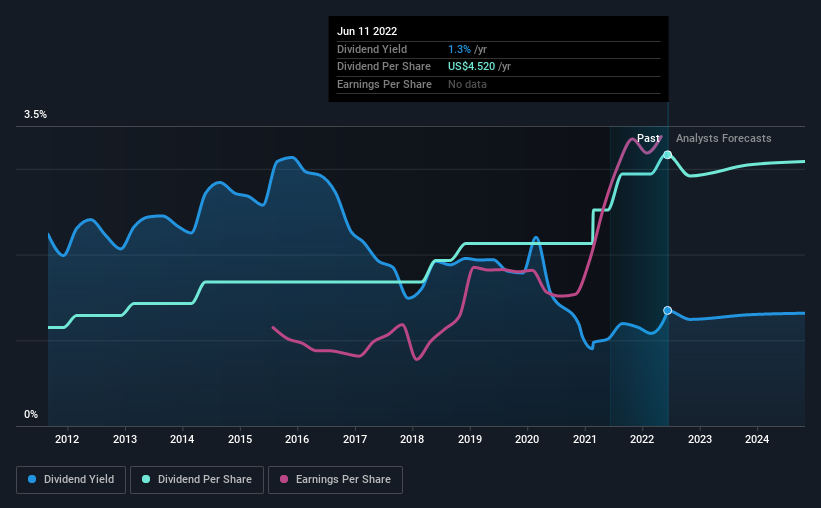Deere (NYSE:DE) Is Increasing Its Dividend To US$1.13
Deere & Company (NYSE:DE) will increase its dividend on the 8th of August to US$1.13. This takes the annual payment to 1.3% of the current stock price, which unfortunately is below what the industry is paying.
View our latest analysis for Deere
Deere's Earnings Easily Cover the Distributions
If it is predictable over a long period, even low dividend yields can be attractive. Before making this announcement, Deere was paying a whopping 104% as a dividend, but this only made up 21% of its overall earnings. While the business may be attempting to set a balanced dividend policy, a cash payout ratio this high might expose the dividend to being cut if the business ran into some challenges.
The next year is set to see EPS grow by 28.2%. Assuming the dividend continues along recent trends, we think the payout ratio could be 18% by next year, which is in a pretty sustainable range.
Deere Has A Solid Track Record
The company has an extended history of paying stable dividends. Since 2012, the first annual payment was US$1.64, compared to the most recent full-year payment of US$4.52. This works out to be a compound annual growth rate (CAGR) of approximately 11% a year over that time. We can see that payments have shown some very nice upward momentum without faltering, which provides some reassurance that future payments will also be reliable.
The Dividend Looks Likely To Grow
Some investors will be chomping at the bit to buy some of the company's stock based on its dividend history. Deere has impressed us by growing EPS at 28% per year over the past five years. Rapid earnings growth and a low payout ratio suggest this company has been effectively reinvesting in its business. Should that continue, this company could have a bright future.
Our Thoughts On Deere's Dividend
In summary, while it's always good to see the dividend being raised, we don't think Deere's payments are rock solid. While Deere is earning enough to cover the payments, the cash flows are lacking. This company is not in the top tier of income providing stocks.
Companies possessing a stable dividend policy will likely enjoy greater investor interest than those suffering from a more inconsistent approach. Still, investors need to consider a host of other factors, apart from dividend payments, when analysing a company. For example, we've identified 3 warning signs for Deere (1 is concerning!) that you should be aware of before investing. Looking for more high-yielding dividend ideas? Try our collection of strong dividend payers.
Have feedback on this article? Concerned about the content? Get in touch with us directly. Alternatively, email editorial-team (at) simplywallst.com.
This article by Simply Wall St is general in nature. We provide commentary based on historical data and analyst forecasts only using an unbiased methodology and our articles are not intended to be financial advice. It does not constitute a recommendation to buy or sell any stock, and does not take account of your objectives, or your financial situation. We aim to bring you long-term focused analysis driven by fundamental data. Note that our analysis may not factor in the latest price-sensitive company announcements or qualitative material. Simply Wall St has no position in any stocks mentioned.

 Yahoo Finance
Yahoo Finance 
